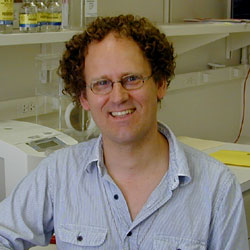| |
| |
| Benjamin H. White, Ph.D., Investigator |
 |
Dr. White received a B.A. in Physics and Mathematics from the University of Oregon (Honors College) and a Ph.D. in the Neural Sciences from Washington University in St. Louis. His graduate work with Jonathan Cohen focused on the structural basis of ion channel gating. Postdoctoral work with Leonard Kaczmarek at the Yale University School of Medicine focused on mechanisms of calcium channel modulation by PKC. While at Yale, Dr. White's interests shifted to the potential use of ion channels to investigate the neuronal substrates of behavior. Working between the Kaczmarek laboratory and the laboratory of Haig Keshishian, he showed that a genetically modified Shaker K+ channel (called the "Electrical Knock-Out," or EKO channel) could be used to inhibit the electrical activity of targeted cells in Drosophila. He further demonstrated that random expression of the EKO channel in Drosophila (using Gal4 enhancer-trap lines) could be used to generate behavioral deficits. His laboratory is exploiting this observation to develop behavioral screens, analogous to classic genetic screens, to identify the neurons underlying specific behaviors.
|

|
Staff:
- Dr. Fengqiu Diao, Ph.D., Research Fellow, (301) 451-4015 diaof@mail.nih.gov
- Ms. Patricia Grace, B.Sc., Postbaccalaureate IRTA, (301) 451-4016 gracep@mail.nih.gov
- Dr. Haojiang Luan, M.D., Ph.D., Postdoctoral Fellow, (301) 451-4437 LuanH@intra.nimh.nih.gov
- Dr. Nathan Peabody, Ph.D., Contractor peabodyn@intra.nimh.nih.gov
- Ms. Juhi Shukla, M.Sc, Technical IRTA, (301) 451-4016 shuklaj@mail.nih.gov
Research Interests:
While considerable progress has been made in understanding the molecular and cellular foundations of nervous system function, we are still far from understanding the integrative activities that give rise to behavior. Historically, this is attributable to the lack of tools for manipulating the activities of individual neurons or groups of neurons in living, behaving animals. Emerging tools for such manipulation, in the form of genes that can be selectively expressed in subsets of neurons and whose products alter neuronal activity, have been most compellingly used in the fruit fly, where researchers have been able to take advantage of the Gal4-UAS system, a general method for cell-type specific, and temporally restricted, expression of genes of interest. In Drosophila, it is now possible to turn specific subsets of neurons off and on in living, behaving animals.
My laboratory is actively engaged in generating and exploiting methods for the identification and analysis of neuronal circuits. We have introduced several new tools for the targeted manipulation of neuronal activity, including tools for enhancing neuronal excitability (see Luan et al. (2006) J. Neurosci. 26:573-584), and tools for systematically restricting manipulations to small subsets of neurons (Luan et al. (2006) Neuron 52:425-436). The latter technique extends the Gal4-UAS system and promises to permit the identification and characterization of neuronal circuits underlying behavior in unprecedented detail.
We are applying the emerging methods in circuit mapping to understanding the neuronal basis of a hormonally-governed behavior in fruit flies that combines both innate and adaptive aspects. Directly after metamorphosis, flies use environmental cues to select a perch, and then expand their wings by initiating two hormonally-driven behaviors. By selectively targeting and manipulating neuronal function, we have succeeded in identifying three core groups of neurons that regulate this process. We are currently studying the interactions between these groups and are attempting to identify further components of the neural network governing wing expansion.
|
Selected Recent Publications:
Luan, H and White, B.H. (2007) Combinatorial Methods for Refined Neuronal Gene Targeting, Curr Opin Neurobiol 17, 572-80.
Luan, H., Peabody, N.C., Vinson, C.R., and White B. H. (2006) Refined Spatial Manipulation of Neuronal Function by Combinatorial Restriction of Transgene Expression., Neuron 52, 425-436.
Luan H, Lemon W. C., Peabody N, Pohl J. B., Zelensky P. K., Wang D, Nitabach M. N., Holmes T. C., and White B. H. (2006) Functional Dissection of a Neuronal Network Required for Cuticle Tanning and Wing Expansion in Drosophila, Journal of Neuroscience 26, 573-584.
Joiner, W.J., Crocker, A., White, B.H., and Sehgal A. (2006) Sleep in Drosophila is regulated by adult mushroom bodies., Nature 441, 757-60.
Nitabach M.N., Wu Y, Sheeba V, Lemon W.C., Strumbos J, Zelensky P.K., White B.H., Holmes T.C. (2006) Electrical Hyperexcitation of Lateral Ventral Pacemaker Neurons Desynchronizes Downstream Circadian Oscillators in the Fly Circadian Circuit and Induces Multiple Behavioral Periods., Journal of Neuroscience 26, 479-89.
Mosca T. J., Carrillo R. A., White B. H., Keshishian H. (2005) Dissection of synaptic excitability phenotypes by using a dominant-negative Shaker K+ channel subunit., Proc Natl Acad Sci U S A. 102, 3477-82.
All Selected Publications
Contact Information:
Dr. Benjamin H. White
Laboratory of Molecular Biology, NIMH
Porter Neuroscience Research Center
Building 35, Room 1B-1012
35 Convent Drive, MSC 4035
Bethesda, MD 20892-4035
Telephone: (301) 435-5472 (office),
(301) 402-8658 (laboratory),
(301) 402-0245 (fax)
Email: whiteb@intra.nimh.nih.gov
|
|















